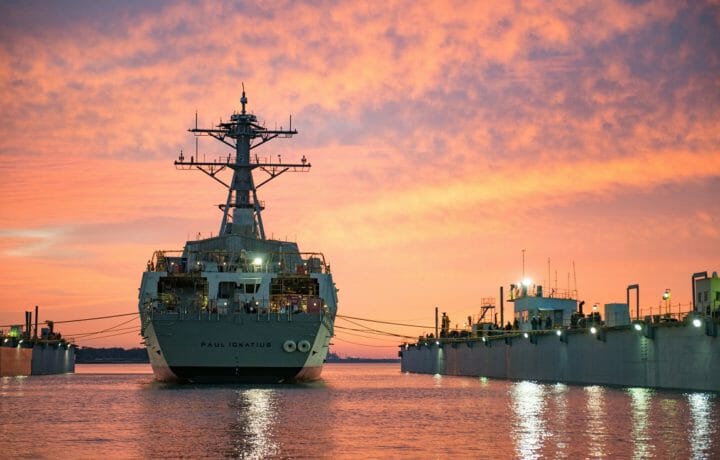The United States Navy announced that it will begin to revert its destroyers back to mechanical controls, including a physical throttle and traditional helm control system; and away from the more modern touchscreen systems that had been increasingly used throughout the fleet. This change in controls will take place over the next 18 to 24 months. It comes after reviews of the August 2017 fatal collision of the USS John S. McCain (DDG-56) and the Liberian-flagged chemical tanker Alnic MC off the coasts of Singapore and Malaysia.
A National Transportation Safety Board (NTSB) investigation concluded that a lack of Navy oversight and training were the primary causes of the collision, which killed 10 sailors. “A lack of effective operational oversight of the destroyer by the U.S. Navy, which resulted in insufficient training and inadequate bridge operating procedures,” was how the investigation was summed up. Those findings were a break from the U.S. Navy’s own assessment, which placed the blame for the early morning collision on the ship’s command.
The investigation by the NTSB also found that the touchscreen system was complex, and that sailors on the McCain had been not been adequately trained to use the new systems.
Following the Navy’s Comprehensive Review related to the McCain, as well as another collision involving the USS Fitzgerald (DDG-62), the Naval Sea Systems Command made its own recommendations to replace the touchscreen control systems.
While speaking at the American Society of Naval Engineers’ annual Fleet Maintenance and Modernization Symposium, Program Executive Officer for Ships Rear Adm. Bill Galinis said that systems were overly complex, and that in an effort to stay innovative while adopting new technology, “we got away from the physical throttles, and that was probably the number-one feedback from the fleet – they said, just give us the throttles that we can use.”
The U.S. Navy will now design and install physical throttles on all DDG-51 class ships with the Integrated Bridge and Navigation Systems (IBNS).
USN Mechanics: A Touchy Subject
There seems some irony that today’s sailors – especially younger sailors who grew up in the days of smartphones and tablet devices – aren’t more readily accustomed to touchscreen interfaces.
“It is a bit confusing, since it contradicts conventional wisdom about the value of providing younger service people with familiar tools and with the established value of so many other touchscreen interfaces,” said Charles King, principal analyst at Pund-IT.
“I suspect the failure of the U.S. Navy’s system was either due to the user interface (UI) not being up to snuff or because the links between the UI and related hydraulic systems were flawed in some way,” King told ClearanceJobs. “It’s impossible to know without examining the touch screen UI and system, and I doubt an invitation to do so will be forthcoming. It’d also be fascinating to know which contractor(s) designed, built and installed the touchscreen systems, but those details are likely classified.”
The U.S. Navy’s report highlighted how the complexity of the system – on a U.S. Navy warship – was a world away from video games on a tablet.
“This is a classic case of information overload and a poorly thought out Human Machine Interface,” explained Scott Clark, global program director for defence at U.K.-based Frost & Sullivan.
“Did you know that many of the high-end sports cars often score low in customer reviews like JD Powers because of their infotainment system?” pondered Jim McGregor, principal analyst at TIRIAS Research.
“Customers find it difficult to navigate multiple screens just to change the radio station,” McGregor told ClearanceJobs. “So, one issue may be the user interface. If it is too complicated, which is easy to do when you want to be able to control everything from one system, then it may be difficult to navigate in an emergency situation.”
This certainly was the case with the McCain. Even those sailors who know their way around tablet interfaces found the interface with the Integrated Bridge and Navigation Systems to be overly complex. It also lacked the tactical feedback that is provided via a mechanical control.
“Touchscreen solutions don’t provide haptic feedback to the user,” explained McGregor. “I would not want to back up my truck or backhoe using a touchscreen because I need to know exactly what results my actions have on the vehicle. Even if it is fly-by-wire, meaning that the entire system is electronic and not mechanical, having that feedback to know how far to turn the wheel is extremely valuable.”
There is also a “gray area” in human-electronic system control, added McGregor. “Sometimes you need mechanical solutions for the benefit of the human and sometimes it is better to eliminate the human altogether. This is the challenge in automotive as the industry transitions up the SAE automation levels. Partial autonomy is tricky, which is why many OEMs hope to go straight to full autonomy.”
So until warships can pilot themselves, the controls that have worked for decades are likely better – even for those tech savvy sailors.
“The old ways are sometimes best,” Clark told ClearanceJobs, adding that digitalization for the sake of digitalization doesn’t solve problems but creates new one ones. “There is the old adage, ‘if it ain’t broke don’t fix it.’ There is no reason why they should change to digital interface when they have been using the good old helm control for centuries.”




